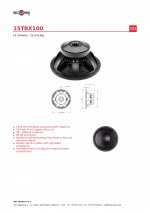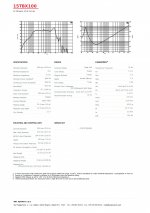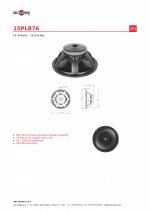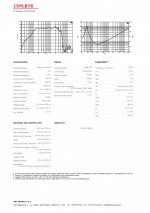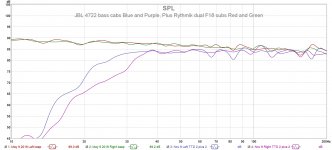When one uses multiple subs this really isn't a tradeoff because you just add another sub. In my system there are six 12-15" woofers. Three are subs and three are the low end of the three mains. This really is the optimal solution to the low frequency problems in small rooms (room design being seriously important as someone pointed out.)
Understood [and my point], I was referring to the common use of minimal number of very high power handling subs as the trade-off rather than our 'as many as it takes' way.
GM
I was PM'd by someone who wants some links for how to use multiple subs. There are so many: perhaps someone could link to a few that are enlightening. There is the Welti paper and several threads here. I don't remember if I have anything at my sight on this.
No point in my replying only to the PM. I am sure everyone would benefit.
No point in my replying only to the PM. I am sure everyone would benefit.
Is higher or lower better?
Higher is better if you want to go loud, lower is better if you want bass extension. A HF compression driver can hit 50%.
You guys are blowing my mind right now....so lighter cones are harder to bring farther up the register? The more you know I guess.
Ro808 is this a fancier version of the sensitivity spec?
Ro808 is this a fancier version of the sensitivity spec?
Ro808 is this a fancier version of the sensitivity spec?
Different way to express the same thing.
Higher is better if you want to go loud, lower is better if you want bass extension. A HF compression driver can hit 50%.
Thanks!
Let’s compare the Acoustic Elegance TD15m vs TD15H, both play almost the same frequency range the M is more efficient, the H has a few ms faster latency...The M does so with less excursion needed....so the M is a better subwoofer with a lighter cone as well...this is what I see.
Efficiency values are not a measure of quality or performance per se. These are merely indicative of... the driver's efficiency, and as such dependent on the construction (cone, suspension, motor etc.). In general (sub)woofers are less efficient than midwoofers.
As can be seen, both the Faital drivers are not terribly efficient.
This was illustrated before in the post about amp. power vs Xmax.
There's no free lunch in this respect.
According to Wikipedia:
"η0 - Reference Efficiency
Specified in percent (%). Comparing drivers by their calculated reference efficiency is often more useful than using 'sensitivity' since manufacturer sensitivity figures are too often optimistic."
This is true, if you know what you're actually comparing.
As can be seen, both the Faital drivers are not terribly efficient.
This was illustrated before in the post about amp. power vs Xmax.
There's no free lunch in this respect.
According to Wikipedia:
"η0 - Reference Efficiency
Specified in percent (%). Comparing drivers by their calculated reference efficiency is often more useful than using 'sensitivity' since manufacturer sensitivity figures are too often optimistic."
This is true, if you know what you're actually comparing.
Last edited:
Earl's approach to multiple subwoofers in small rooms (video) (PowerPoint)
Low-Frequency Optimization Using Multiple Subwoofers
Subwoofers: Optimum Number and Locations
Both from Todd Welti
Multiple Subwoofers: Optimize Them With Multi-Sub Optimizer Software Excellent software from diyAudio member andyc
My approach for integrating multi subs (dual subs) with Audiolense. I liked it so much, I ended up getting larger subs 😉
Member DallasJustice approach to integrating multiple subs (4 subs) using a different approach for his JBL M2's, again using Audiolense. What's interesting is that Michael has tried a number of approaches and mentions some pro's/con's with each one.
Low-Frequency Optimization Using Multiple Subwoofers
Subwoofers: Optimum Number and Locations
Both from Todd Welti
Multiple Subwoofers: Optimize Them With Multi-Sub Optimizer Software Excellent software from diyAudio member andyc
My approach for integrating multi subs (dual subs) with Audiolense. I liked it so much, I ended up getting larger subs 😉
Member DallasJustice approach to integrating multiple subs (4 subs) using a different approach for his JBL M2's, again using Audiolense. What's interesting is that Michael has tried a number of approaches and mentions some pro's/con's with each one.
Earl's approach to multiple subwoofers in small rooms (video) (PowerPoint)
Low-Frequency Optimization Using Multiple Subwoofers
Subwoofers: Optimum Number and Locations
Both from Todd Welti
Multiple Subwoofers: Optimize Them With Multi-Sub Optimizer Software Excellent software from diyAudio member andyc
My approach for integrating multi subs (dual subs) with Audiolense. I liked it so much, I ended up getting larger subs 😉
Member DallasJustice approach to integrating multiple subs (4 subs) using a different approach for his JBL M2's, again using Audiolense. What's interesting is that Michael has tried a number of approaches and mentions some pro's/con's with each one.
A big thank you for the links!
We know that lighter cones add efficiency, but they tend to "loose-it" faster and harder so they are hard to take up to 1 kHz. The heavier cone B&C are very well controlled in this region. And there is absolutely no way that one cannot use the frequency response at the high end of the woofer as part of the crossover. I don't like the low mass woofer cones.
Here we will have to agree to partly disagree, I guess.
The TBX100 is indeed well controlled up to 1000Hz, but the PLB76's extended bandwith provides additional leeway wrt the crossover.
While the TBX100 is better >500Hz than the BG100 (shown before), I would personally prefer the PLB76 to both.
Attachments
Last edited:
@moray np. Spent 10 years in Calgary, love the Bow River!
@camplo Some food for thought. The monster JBL cabs I have with the dual 15" are tuned to 40 Hz and with a little DSP can get a but lower, but not much being ported. Really stiff cones and some serious output - drums sound like drums when turned up - great transient output. I have an acoustic drum kit in the same room.
But the very bottom octave was missing and I thought to add a couple of subs. I went with dual Rythmik L12 entry level so if I did not like them, I could either sell them or pair them with my Kef LS50's in a 2nd system.
As it turns out, loved them. Added such weight to the sound that I decided to upgrade to a pair of F18's to keep up with the JBL ported bass cabs.
Here is the measured difference between the JBL bass cabs by themselves and then integrated with dual subs:
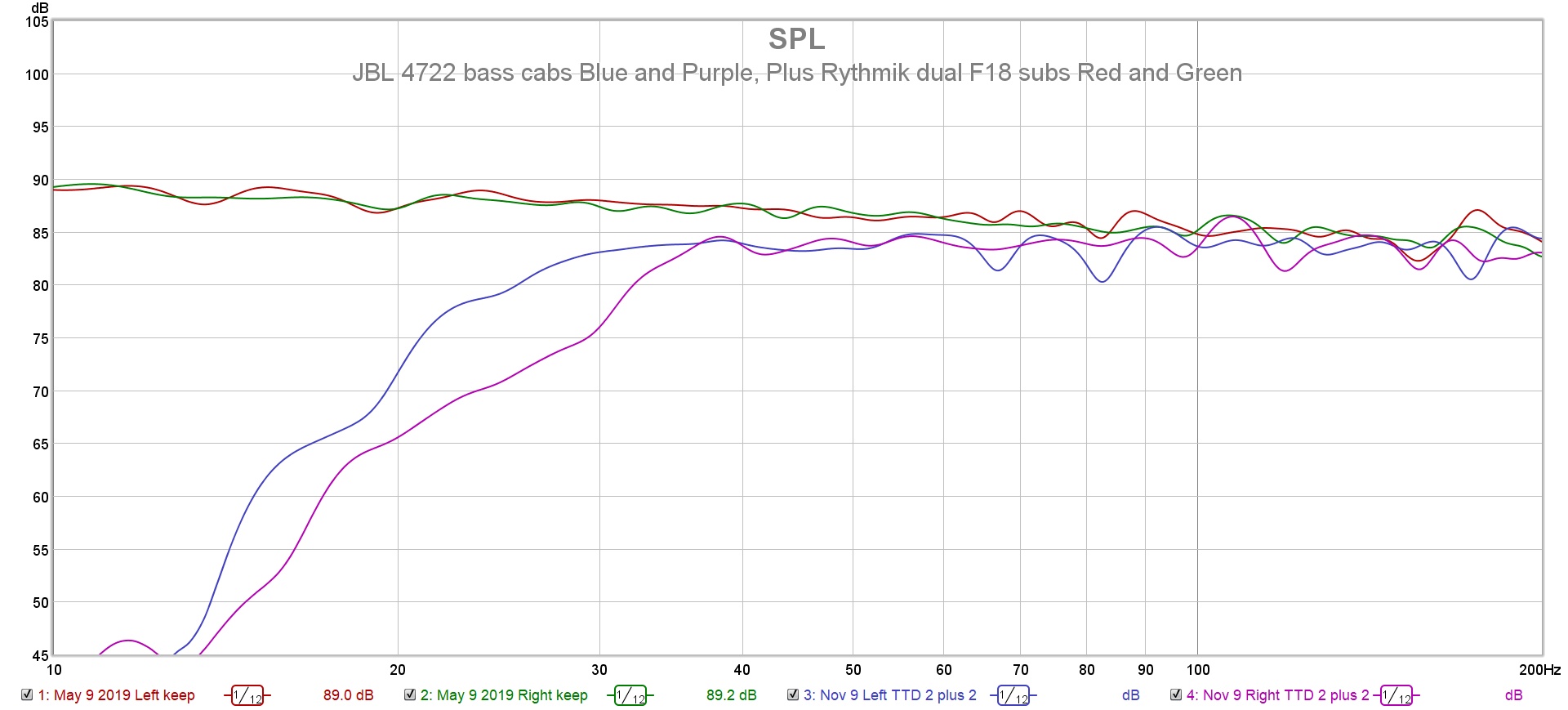
The only other 15" driver and cab combo I have seen in a 2 way that actually really makes it to 20 Hz is the JBL M2. Mind you there is quite a bit of eq on the production versions.
As mentioned in the link above, even Michael with the M2's opted for 4 subs. And since the release of the M2's JBL has added a companion sub for the M2's.
I know it is no longer a 2 way, but depending on the type of music you listen to and if you truly want 20 Hz to 20 kHz performance...
@camplo Some food for thought. The monster JBL cabs I have with the dual 15" are tuned to 40 Hz and with a little DSP can get a but lower, but not much being ported. Really stiff cones and some serious output - drums sound like drums when turned up - great transient output. I have an acoustic drum kit in the same room.
But the very bottom octave was missing and I thought to add a couple of subs. I went with dual Rythmik L12 entry level so if I did not like them, I could either sell them or pair them with my Kef LS50's in a 2nd system.
As it turns out, loved them. Added such weight to the sound that I decided to upgrade to a pair of F18's to keep up with the JBL ported bass cabs.
Here is the measured difference between the JBL bass cabs by themselves and then integrated with dual subs:
The only other 15" driver and cab combo I have seen in a 2 way that actually really makes it to 20 Hz is the JBL M2. Mind you there is quite a bit of eq on the production versions.
As mentioned in the link above, even Michael with the M2's opted for 4 subs. And since the release of the M2's JBL has added a companion sub for the M2's.
I know it is no longer a 2 way, but depending on the type of music you listen to and if you truly want 20 Hz to 20 kHz performance...
Attachments
That's impressive Mitch!
The Red and Green extend to <10Hz???
In my country, the blue curve would suffice to shake the walls and terrorize the neighbours.
A short follow-up on my previous post:
The TBX100 is obviously a well engineered woofer, with all the bells and whistles for HQ, high SPL PA use.
It does need some power to come to life though.
The PLB76's higher efficiency (and sensitivity) is a better match to low watt (high-end) amplifiers.
The Red and Green extend to <10Hz???
In my country, the blue curve would suffice to shake the walls and terrorize the neighbours.
A short follow-up on my previous post:
The TBX100 is obviously a well engineered woofer, with all the bells and whistles for HQ, high SPL PA use.
It does need some power to come to life though.
The PLB76's higher efficiency (and sensitivity) is a better match to low watt (high-end) amplifiers.
Last edited:
At not much actual SPL as the Rhythmics don't have much volume displacement. Then factor in Fletcher Munson...The Red and Green extend to <10Hz???
Here’s a thing. Open baffle sub vs closed/ported.
It seems that because the sub bass waves are so big, they come across as being omnidirectional. Is that true enough that the two types of implications are at least very similar?
I ask because some one spoke up a Linkwitz Riley sub design as being their preference, just wondering if an open baffle sub could suffice in my set up. Open baffle speakers are not used in the studio typically, since they are so room stimulating. My thinking was that sub bass frequency was really no different in comparison no matter the source, unless speaking of horns.
It seems that because the sub bass waves are so big, they come across as being omnidirectional. Is that true enough that the two types of implications are at least very similar?
I ask because some one spoke up a Linkwitz Riley sub design as being their preference, just wondering if an open baffle sub could suffice in my set up. Open baffle speakers are not used in the studio typically, since they are so room stimulating. My thinking was that sub bass frequency was really no different in comparison no matter the source, unless speaking of horns.
That's impressive Mitch!
The Red and Green extend to <10Hz???
In my country, the blue curve would suffice to shake the walls and terrorize the neighbours.
Yes, f3 is 6 Hz in my room. Can make the foundation shake. The measurement was taken at reference level ~83 dB SPL at the listening position some 3 meters away.
See CEA 2010 Max passing SPL: Rythmik Audio • 18" servo subwoofer F18
X 2 subs is more than enough for peak reference music level (not LFE) i.e. 105 dB SPL at 20 Hz, not including room gain. If I wanted more, I would have gone with the vented version, but in practice, this is more than enough for clean concert level at home.
I didnt mean to steam roll past your post Mitchba, just trying to keep the energy flowing into my last post.
The links you posted are awesome and your system is awesome and you are awesome too 🙂
The links you posted are awesome and your system is awesome and you are awesome too 🙂
Hmmm............
with numbers like that on the sealed rhythmic (F3 near 31, F9 near 20hz), those are almost identical to the 15" Dayton rss390hf sealed (4.4ft3), and 200w (assuming no loss) makes for 102db@20hz.
Now do 2 daytons in push-pull (slot loaded) for +6db, F3 still 31hz, but 108db@20hz, wow.
with numbers like that on the sealed rhythmic (F3 near 31, F9 near 20hz), those are almost identical to the 15" Dayton rss390hf sealed (4.4ft3), and 200w (assuming no loss) makes for 102db@20hz.
Now do 2 daytons in push-pull (slot loaded) for +6db, F3 still 31hz, but 108db@20hz, wow.
- Home
- Loudspeakers
- Multi-Way
- Is it possible to cover the whole spectrum, high SPL, low distortion with a 2-way?
